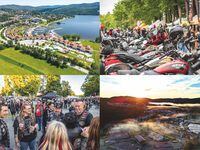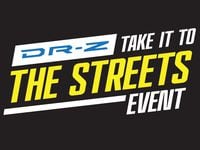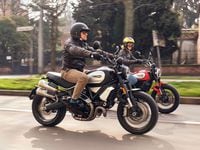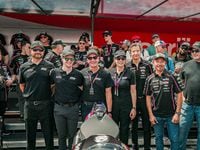There are two types of people who ride the Cannonball: Mechanics, and those who can afford to bring one along. Sometimes the afforders are decent wrenches too, but hire even better ones: whizzes with side-of-the-road magic in their fingers, rewinders of magnetos, truck-axle crankpin makers. All such repairs were made on the first Cannonball two years ago, when the entry cut-off was ‘Pre-1916.’ Riding 100-year old motorcycles across America was a recipe for destruction, as no centurion machine of any stripe or wheel count gets ridden so far, ever. Yet from a field of 70-odd entries, a round dozen arrived without serious mishap to mar their perfect score. The rest went through mechanical hell.
This unreasonable event also divides entrants according to ambition: Those who ride to Win, and those simply seeking adventure. After five days on the road, the distinction is clear. Some of the ‘winners’ have an old V-twin honed to perfection over many years and miles of use, and great confidence in their machine and their own ability to keep it running. The foolhardy own dozens of old bikes, but have never spent a thousand miles in the saddle of their 1928 Excelsior-Henderson 4-cylinder. These same fellows have the wherewithal to bring enormous trailers with whole spare engines in crates, boxes of magnetos and transmissions, and one or two mechanics to help with, or do all of, the repair work. A few are prima donnas whose ‘crews’ are already sick of their employers.
The Cannonball is not really fun. In our fantasies, the hearty chuckle of a 1926 JD Harley singing over hill and dale is comfortable and easy, but the reality is 7am start times, 10 or 12 hours in the saddle, and the vicissitudes of heat, humidity, hours and hours of crosswinds, cold, rain, and hail… and if it’s raining in Wyoming, we’ll get snowed on crossing 11,000-foot Beartooth Pass. Plus, you’d better keep a sharp eye on 8 or 12 pages of daily route sheets… which are given out only at each day’s end.
Three classes are competing for the total-mileage trophy: Class 1 is the British class, or seems to be, for machines under 750cc. By yesterday, no small-bore bike had a perfect mileage score, so the Rudge, BSA, Triumph, Sunbeam and Velocette entries are out of the running for the Big Prize (a lovely Jeff Decker bronze sculpture). Class 2 is for 750-1000cc bikes, and currently ten have perfect scores including last year’s winner, Brad Wilmarth, riding a 1913 Excelsior F-Head V-twin. Wilmarth is currently in the lead, because he’s on the oldest bike. Class 3, for over-1000cc bikes, has 17 no-trouble bikes.
And then there are the breakdowns. Two days ago, in Anamosa, Iowa, I witnessed a completely melted piston on a JD Harley (which was cleaned out and a new pair installed), an engine replacement on a Henderson 4, a gearbox rebuild, welded fender brackets, and new valve lifters installed--all of which was only seen because my own motorcycle has given me nothing but Trouble, from day one. I sat for eight hours attempting to sort out cambox issues on my 1928-ish Velocette KTT racer. The first work space where I spread the Velo out was inadequate when I discovered I’d need to shorten my camshaft by 0.092-inch, and needed a lathe. So I packed up the bike, spares, tools, and photographic equipment (oh, I’m taking 1850s era tintypes on the road, too… my Sprinter is a mobile darkroom), from the National Motorcycle Museum to the J&P Enterprises garage. There I pressed on a new cam, follower pads into the rockers, and thought it would all be good and I’d be on the road. But it wasn’t and I’m not. That makes about 18 hours of solid wrench time on my bike in five days; making new valves and sorting out issues… which still aren’t sorted.
So, until the Cannonball takes a day off at Sturgis, and I have access to a really good machine shop to sort out my cam situation, I’ll be taking cool photos, enjoying the scenery… and sucking up my pride.















/cloudfront-us-east-1.images.arcpublishing.com/octane/2PLTVHXY7FDSPFHKU5CFOC43ZY.jpg)
/cloudfront-us-east-1.images.arcpublishing.com/octane/B6M3WTRLFZGNXBEATNXPVGBBD4.jpg)
/cloudfront-us-east-1.images.arcpublishing.com/octane/4CMH3FI73BEM5D6MFYX42FLDSQ.jpg)
/cloudfront-us-east-1.images.arcpublishing.com/octane/RIHAPYNWU5H3XAOXNOPRWCBTQA.jpg)
/cloudfront-us-east-1.images.arcpublishing.com/octane/HU4NUBCL3VAFZA75VYRCMAUHVM.jpg)
/cloudfront-us-east-1.images.arcpublishing.com/octane/OB43AZK7TRA6XLZL5WRDVW2TDA.jpg)
/cloudfront-us-east-1.images.arcpublishing.com/octane/5G44Y3FXWNFSTEQKCA355PXOPU.jpg)

/cloudfront-us-east-1.images.arcpublishing.com/octane/XRI4GTLCVBA5NESASCBIR5LYQI.jpg)
/cloudfront-us-east-1.images.arcpublishing.com/octane/EF7566PXARGMBAOMLWTECYL3LE.jpg)





/cloudfront-us-east-1.images.arcpublishing.com/octane/3LASNXSWUZFFPISURDJF3OCWBU.jpg)
/cloudfront-us-east-1.images.arcpublishing.com/octane/2BHJKWUTBNBTLMQCKDNVEG6DKQ.jpg)
/cloudfront-us-east-1.images.arcpublishing.com/octane/MPHXIIV54NAU5L6E4SYZHCXVRM.jpg)



/cloudfront-us-east-1.images.arcpublishing.com/octane/WYXFHF4ZOBBTXELIZDB2FJXU64.jpg)
/cloudfront-us-east-1.images.arcpublishing.com/octane/K5FNV7ONUVDXJJ2H5BIWUGBGTI.jpg)
/cloudfront-us-east-1.images.arcpublishing.com/octane/MGVKP5VTNJHQ7FWNAHIWX4OHO4.jpg)